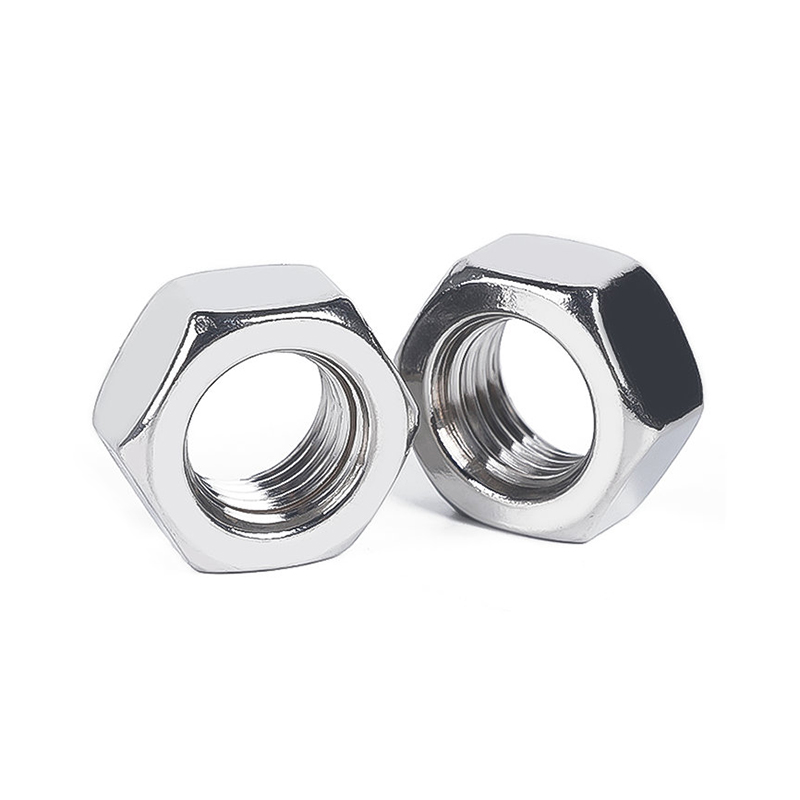Over-tightening stainless steel hex nuts can lead to several potential risks, which may compromise the performance, safety, and longevity of the fastening system.
1. Thread Stripping
Over-tightening can cause the threads on both the stainless steel hex nut and the bolt or stud to deform, leading to thread stripping. This can prevent the nut from being properly secured and may require replacement of both components, compromising the integrity of the fastening.
2. Material Deformation or Damage
Stainless steel is a strong material, but over-tightening can lead to plastic deformation or yielding of the nut or bolt. The material may stretch or distort, reducing the effectiveness of the fastener and potentially weakening the connection.
In high-strength applications, such as in aerospace or automotive industries, over-tightening can lead to catastrophic failure if the deformation significantly alters the mechanical properties of the components.
3. Loss of Clamping Force
Over-tightening can distort the geometry of the stainless steel hex nut, causing it to lose its ability to properly clamp down the connected components. As a result, the connection may become loose over time, leading to potential failure or vibrations, particularly in high-stress or dynamic environments.
4. Increased Risk of Thread Galling
Thread galling, a form of wear caused by the friction between metal threads, can be aggravated by over-tightening. Stainless steel is prone to galling, and when excessive torque is applied, the threads can seize or become damaged, leading to difficulty in disassembly and the need for component replacement.
5. Cracking or Fracturing
Over-tightening may cause cracking or fracturing of the stainless steel hex nut, especially if it has any manufacturing defects or if it is made from a lower-grade stainless steel. Cracks can spread, weakening the fastener and potentially leading to a complete failure of the connection.
6. Overstressed Joint
If a hex nut is over-tightened, the stress applied to the connected joint can exceed its designed tolerance. This can result in an uneven distribution of forces across the connection, potentially leading to joint failure or material fatigue over time.

7. Reduced Corrosion Resistance
In some cases, over-tightening can create localized stress corrosion cracking (SCC) in stainless steel, especially in the presence of moisture or corrosive environments. The high stress can promote the formation of cracks, which may then serve as entry points for corrosive agents, compromising the overall durability of the fastener.
8. Damage to the Fastening Tool
Over-tightening may also strain the tools used to tighten the hex nuts, potentially causing damage or premature wear. If a torque wrench or impact tool is used improperly, the tool itself may fail, leading to the need for tool replacement.
9. Difficulty in Disassembly
Over-tightened nuts can become difficult or impossible to remove without causing damage. The excessive torque applied during installation may cause the nut to become seized or create excessive friction between the nut and the threads, making disassembly problematic and time-consuming.
10. Vibration Loosening
Interestingly, while over-tightening initially secures the nut, it can sometimes make the fastening system more susceptible to vibration loosening. Over-tightened nuts can distort the threads in such a way that they no longer fit properly, increasing the risk of the nut loosening over time due to vibration or dynamic forces.
To avoid these risks, it is essential to follow the manufacturer’s recommended torque specifications when tightening stainless steel hex nuts. Using a torque wrench or torque limiting tool can help ensure that the correct amount of force is applied, preventing over-tightening and maintaining the integrity of the fastening system. Regular inspections and maintenance are also important to ensure that nuts and bolts remain properly secured throughout their service life.

 English
English 中文简体
中文简体 Español
Español русский
русский عربى
عربى








